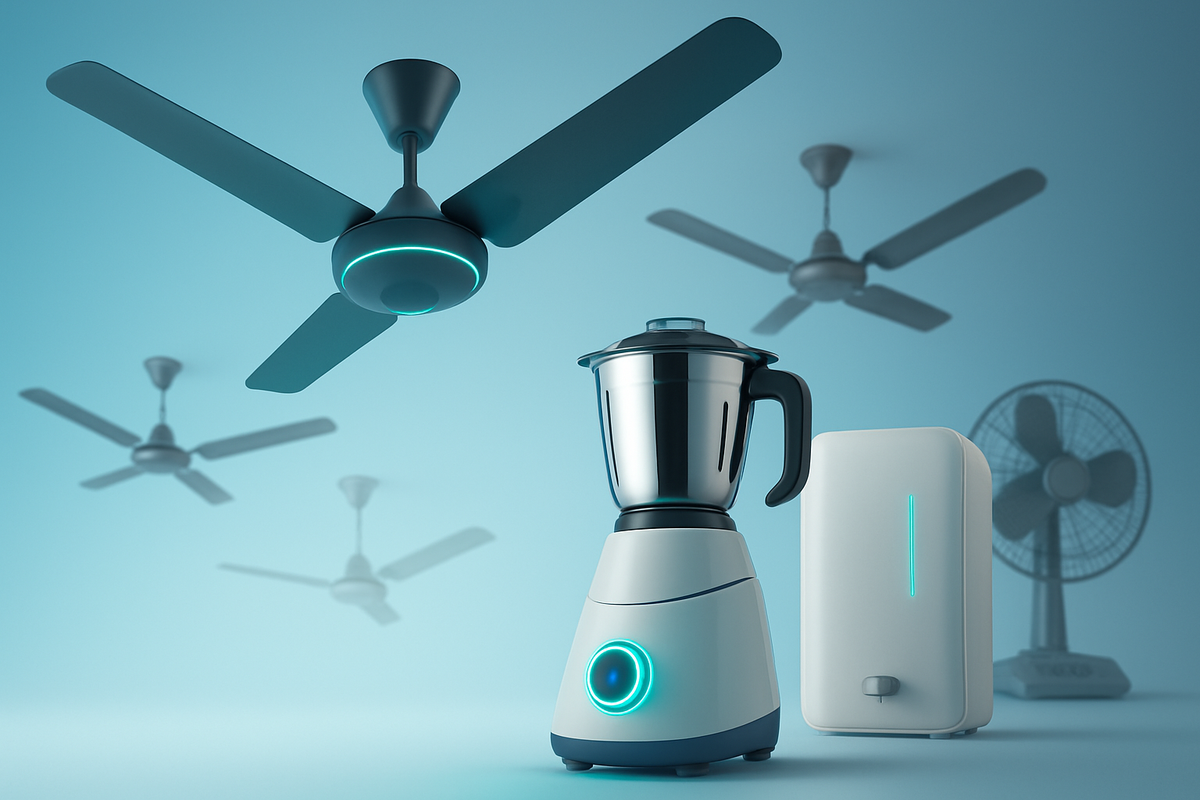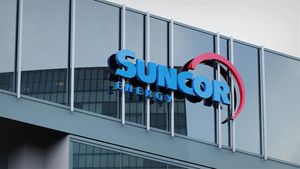
Atomberg Technologies, a brainchild of IIT-Bombay graduates Manoj Meena and Sibabrata Das, is making significant waves in the home electronics sector. The company, renowned for its energy-efficient smart fans, is aggressively expanding its product portfolio, directly challenging long-standing industry behemoths. This strategic foray into a broader range of smart home appliances signals a potential paradigm shift in a market traditionally dominated by conventional technology and established brand loyalty. Atomberg's innovative approach, centered on sustainable and smart solutions, could redefine consumer expectations and force competitors to accelerate their own technological advancements.
The immediate implications of Atomberg's aggressive expansion are multifaceted. For consumers, it promises a wider array of energy-efficient and smart home solutions, potentially leading to lower electricity bills and enhanced convenience. For the industry, it heralds increased competition, particularly in segments like fans, mixer grinders, and water purifiers, where Atomberg is introducing BLDC motor technology and IoT capabilities. This disruptive entry could pressure established players to either innovate rapidly or risk losing market share to a nimble, tech-first challenger. Investors will be keenly watching how this dynamic plays out, as Atomberg's success could pave the way for other tech-driven startups to challenge traditional manufacturing giants.
Atomberg's Ascent: From Energy-Efficient Fans to a Smart Home Ecosystem
Atomberg Technologies officially commenced operations in 2015, launching its flagship BLDC (Brushless DC) ceiling fan, the "Gorilla," which dramatically cut power consumption compared to conventional fans. Initially, the company focused on the B2B segment, securing clients like the Tata Group, Infosys, and Indian Railways, thereby validating the energy-saving benefits of their products. This strategic groundwork allowed them to build credibility before transitioning into the B2C domain through online marketplaces in 2016 and expanding into offline retail channels by 2018. The founders, Manoj Meena and Sibabrata Das, both IIT Bombay alumni, started Atomberg with a clear vision to inject innovation and sustainability into the often-stagnant home appliance market.
The company's diversification beyond fans began in the early 2020s, culminating in the launch of their first non-fan appliance, a BLDC-powered mixer grinder, in early 2022. Atomberg continued this expansion in 2023-2024, introducing new IoT-enabled smart 2.0 fans, including the Studio Smart+ series, and partnering with platforms like Blinkit in April 2024 to enhance distribution. Their product line now encompasses a range of smart ceiling, pedestal, and exhaust fans, mixer grinders, smart water purifiers, and even smart door locks, all underpinned by their core philosophy of energy efficiency and intelligent design. This methodical expansion demonstrates a clear strategy to build a comprehensive smart home ecosystem, moving beyond a single product category to capture a larger share of the domestic appliance market.
The key players involved are Atomberg Technologies, with its founders at the helm, and a host of established Indian appliance manufacturers. Initial market reactions have been a mix of cautious observation and competitive response, with some incumbents beginning to introduce their own BLDC and smart appliance variants. However, Atomberg's early mover advantage in truly smart and energy-efficient solutions has allowed it to carve out a distinct niche, particularly among environmentally conscious and tech-savvy consumers. The company's significant funding rounds, including a $20 million raise in early 2024, underscore investor confidence in its disruptive potential and growth trajectory.
Market Dynamics: Who Wins and Who Loses in the Smart Home Race
Atomberg Technologies' aggressive expansion directly impacts several public companies that have long dominated the Indian home appliance market. Companies like Crompton Greaves Consumer Electricals Ltd. (NSE: CROMPTON), Havells India Ltd. (NSE: HAVELLS), Orient Electric Ltd. (NSE: ORIENTELEC), Usha International, and Bajaj Electricals Ltd. (NSE: BAJAJELEC) are the primary competitors in the fan segment. These established players, with their extensive distribution networks and brand recognition, stand to lose market share if they fail to match Atomberg's innovation in energy efficiency and smart features. Atomberg's emphasis on BLDC motors, which offer significant power savings, directly challenges the core product lines of these companies, many of which still rely heavily on traditional induction motor technology.
Beyond fans, Atomberg's entry into mixer grinders, water purifiers, and smart locks brings it into competition with other diversified consumer durable companies. While specific public competitors for these newer segments might vary, the general trend suggests that any company relying on conventional, non-smart, and less energy-efficient appliances faces a threat. Companies like Symphony Ltd. (NSE: SYMPHONY) and Voltas Ltd. (NSE: VOLTAS), while primarily known for air coolers and air conditioners respectively, also have a presence in broader home appliance markets and could feel the ripple effects of Atomberg's innovation-driven approach.
The potential "winners" in this scenario, besides Atomberg itself, could be component suppliers specializing in BLDC motors, IoT modules, and smart home technologies. Consumers, too, emerge as significant winners, benefiting from increased choice, technological advancements, and the long-term cost savings associated with energy-efficient appliances. The "losers" are likely to be those traditional manufacturers who are slow to adapt, clinging to outdated technology and relying solely on brand legacy without investing in R&D for smart and sustainable alternatives. The competitive pressure from Atomberg will force these incumbents to either innovate or face erosion of their market dominance.
Broader Significance: A Catalyst for Industry-Wide Transformation
Atomberg's strategic move into the broader home electronics market is more than just a new product launch; it's a significant indicator of broader industry trends towards energy efficiency, smart connectivity, and sustainable technology. This event fits perfectly into the global push for smarter homes and reduced carbon footprints. As governments and consumers increasingly prioritize energy conservation, appliances featuring BLDC motors and IoT capabilities are becoming not just desirable but essential. Atomberg's success validates the market demand for such innovations, potentially accelerating the adoption of similar technologies across the entire home appliance sector.
The ripple effects on competitors and partners are substantial. Traditional manufacturers, having witnessed Atomberg's rapid growth and market acceptance, are now compelled to fast-track their own smart appliance development. This could lead to a wave of mergers, acquisitions, or strategic partnerships as incumbents seek to acquire technological expertise or distribution advantages. Furthermore, the emphasis on smart features could drive innovation in related industries, such as home automation platforms, voice assistant technologies (like Amazon Alexa and Google Home), and energy management systems, all of which benefit from a more connected appliance ecosystem.
Regulatory or policy implications might also emerge. As energy-efficient appliances become more prevalent, there could be increased government incentives, subsidies, or stricter energy efficiency standards for home electronics, further favoring companies like Atomberg. Historically, similar disruptions have occurred in various sectors, such as the rise of LED lighting challenging traditional incandescent bulbs or inverter ACs displacing older fixed-speed models. Atomberg's trajectory mirrors these precedents, suggesting that once consumers experience the benefits of superior technology, a market shift becomes inevitable, leaving less innovative players struggling to catch up.
What Comes Next: A Smart Future Unfolds
In the short term, the market can expect Atomberg to continue its aggressive expansion, potentially introducing more product categories and deepening its presence in both online and offline retail channels. The company will likely leverage its brand reputation for energy efficiency and smart features to capture a larger share of the burgeoning smart home market. Competitors, in response, are expected to intensify their R&D efforts, launch their own smart and BLDC-powered variants, and possibly engage in price wars or aggressive marketing campaigns to retain their customer base. The holiday seasons and major sales events in the coming months will be crucial battlegrounds for market share.
Long-term possibilities include Atomberg establishing itself as a dominant player in the Indian smart home ecosystem, potentially expanding into international markets. This could lead to strategic pivots for traditional manufacturers, who might need to divest non-performing conventional product lines or completely reorient their business models towards technology-driven solutions. Market opportunities will emerge for startups specializing in smart home software, AI integration for appliances, and sustainable manufacturing processes. Challenges will include maintaining product innovation, scaling manufacturing efficiently, and navigating the complexities of a highly competitive market with evolving consumer preferences.
Potential scenarios range from Atomberg achieving unicorn status and becoming an acquisition target for a global electronics giant, to it forcing a complete overhaul of the Indian home appliance industry where smart, energy-efficient products become the default. Another scenario could see a fragmented market where Atomberg coexists with a few rapidly innovating incumbents, while laggards slowly fade. Regardless of the exact outcome, the trend towards smarter, more sustainable home electronics is irreversible, and Atomberg is poised to be a key architect of this future.
Wrap-Up: A New Era for Home Electronics
Atomberg Technologies' strategic entry and expansion into the broader home electronics market mark a pivotal moment for the industry. The key takeaway is clear: innovation, particularly in energy efficiency and smart connectivity, is no longer a niche but a central pillar of consumer demand. By leveraging BLDC motor technology and IoT capabilities, Atomberg has not only created a strong brand identity but has also set a new benchmark for performance and sustainability in household appliances. This move underscores a significant shift away from conventional, power-hungry devices towards a future where intelligence and efficiency are paramount.
Moving forward, the market will undoubtedly become more dynamic and competitive. Traditional players can no longer rely solely on their legacy; they must embrace technological advancements or risk being outmaneuvered by agile, tech-focused companies like Atomberg. This increased competition is ultimately beneficial for consumers, who will have access to a wider array of advanced products that offer both cost savings and convenience. The emphasis on smart, connected homes is a trend that will only accelerate, making energy-efficient and intelligent appliances a standard expectation rather than a premium feature.
Investors should closely watch several indicators in the coming months: Atomberg's continued product diversification and market penetration, the innovation pipelines of established competitors, and any shifts in consumer adoption rates for smart home technologies. The success of Atomberg Technologies serves as a powerful testament to the potential of startups to disrupt entrenched markets with superior technology and a clear vision for a sustainable future. The battle for the smart home is just beginning, and Atomberg has fired a compelling opening salvo.
This content is intended for informational purposes only and is not financial advice





